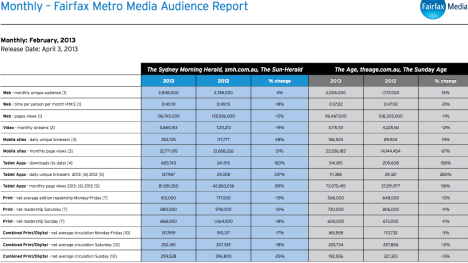Fairfax stops releasing monthly data on its digital progress
Fairfax Media has dropped its monthly updates to the market on its progress on its various digital platforms after little more than a year.
At the time of launching the report, Fairfax said that its metro media audience report was part of “an ongoing commitment to giving key industry stakeholders the most transparent and holistic set of metrics for its mastheads across all platforms.”
However, the publisher has now stopped sharing the monthly reports with the market, meaning a string of metrics not covered by its quarterly audits are no longer available.
The report was the brainchild of former Fairfax Metro boss Jack Matthews who departed in April.
The final update to the market was issued the day before Matthews left, although some monthly data – including that around its falling print circulation – had already been dropped from that document. This weekend, Fairfax increased the cover price of The Sun-Herald – which had been seeing falls of more than 20 per cent – again to $2.50.
The final market update covering February 2013 suggested that while the company’s main metro mastheads the Sydney Morning Herald and The Age were moving forwards on some digital measures, they were going backwards on others.
In particular the time spent per person per month on smh.com.au had dropped by 18 per cent, and The Age by 21 per cent. And monthly video streams had dropped by 19 per cent for the SMH and 12 per cent for The Age.
Monthly page views were down by 12 per cent for the SMH and 11 per cent for The Age.
However, monthly unique audience had grown – by 4 per cent for the SMH and 15 per cent for The Age.
And both sites had shown good mobile growth with The SMH receiving more than 250,000 daily unique mobile browsers, and The Age more than 150,000.
The number of tablet apps downloaded (for free) had risen to 605,000 for The SMH and 541,000 for The Age. However, these apps were only delivering 127,000 and 111,000 daily unique browsers respectively and the numbers appeared to suggest that this was beginning to plateau despite the content being free to users.
Last week, Fairfax launched its paywalls, which see readers asked to pay for most of the content of the apps and a metered model on its websites.
A spokesman for Fairfax told Mumbrella that it had decided to drop the report because a new industry readership metric will be launched later this year. The creation of the metric – named Emma – has mainly been funded via The Readership Works by Fairfax and News Limited. Because the metric is based around readership, it is unlikely it will cover much of the monthly data previously shared by Fairfax.
The spokesman said in a statement: “The FMMAR (Fairfax Metro Media Audience Report) was always an interim solution for our Metro mastheads ahead of the launch of the new metrics from the Readership Works. In the lead up to the launch of ’emma’ (Enhanced Media Metrics Australia) in the first quarter of fiscal 2014, we have suspended issuing the FMMAR as we consider how we will report our audience metrics going forward. We will give an update on digital subscriptions at our August financial results.”
Tim Burrowes



Curious. The whole business strategy is supposed to rest on the total audience. Given the serious doubts about how that turns to cash you wiuld think Fairfax would be extremely careful with the measurement and confidence in it.
I am very confused about how the release of EMMA will act as a like for like replacement for what Fairfax have been releasing in this report. The release of EMMA is still 6-10 months away, in itself an almost unbelievable timescale. EMMA may give us a better understanding of the likely audience duplication between platforms, which will almost certainly be huge. To some extent the desire for a ‘total audience’ figure is meaningless, apart for as a PR message and potentially counterproductive when it is clear how large the duplication is. The platforms are invariably sold and measured independently, so there is little intrinsic commercial value.